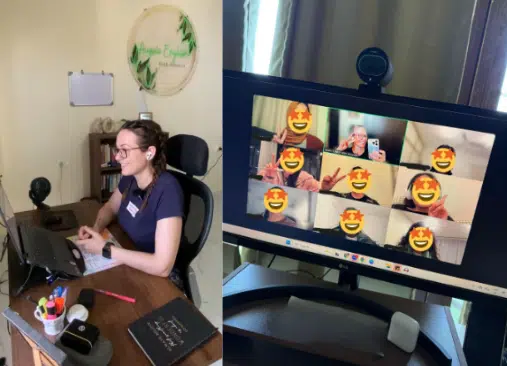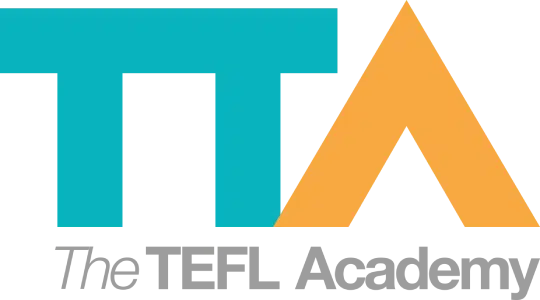How To Market Yourself As An Online English Teacher
Table of Contents
- Introduction
- 1. Build a foundation
- 2. Create an introduction video
- 3. What students want
- 4. Utilise social media
- 5. Establish a niche
- Ongoing tips
In the ever-growing world of online teaching, it can sometimes feel like you’re just another face in a sea of Zoom squares. But fear not! Whether you’re rocking a headset from your kitchen or commanding a virtual classroom in your pyjamas (no judgment), there are plenty of ways to shine brighter than a freshly polished whiteboard.
We chatted to Amanda, a TEFL teacher with a flair for Australian English (g’day, mate!). Qualified with a Level 5 TEFL certification from The TEFL Academy, she now works as a full-time independent online teacher, teaching 1:1 classes and group classes and creating online self-paced courses for English language learners.
She has students from all over the world, and now she wants to share her tips for how to stand out as an online teacher and get more students in front of you.
Let’s get cracking.

1. Build a strong foundation: your profile matters
Amanda first taught online through Cambly in 2019. She then worked through AmazingTalker and Engoo before going completely independent in May 2024.
Read more: Online Teaching Platforms You Need To Know
On AmazingTalker, I got paired with a mentor (they offer that as part of the platform) who helped me with my profile. Looking back, I think she’s the reason I ended up doing Aussie English.
She looked at my educational background, work history, and where I’m from, and said, “To stand out, you should be offering something related to Australian English and culture – maybe also Business or hospitality English since you’ve worked in that space before.” That completely changed the way I saw myself as a teacher.
FYI: Teaching Business English or English for Specific Purposes is a FANTASTIC way to stand out in a crowd of TEFL teachers.
Here’s what I always tell people: treat this role like customer service. You’re providing a service to a customer, and your profile is part of that.
Some people don’t like hearing that, especially if they come from traditional schools, but the online ESL world is cut-throat. You’ve got to show how you’re different.
Think back on your own experiences and how they can be connected to your teaching. You might’ve worked in IT, so focus on teaching English for IT professionals. If you were in marketing, maybe you can help people in that space.
Don’t be afraid to show a bit of your personal story. I live abroad and I’m learning a language (Hindi), so students connect with that – they know I get it. And people are always curious and want to talk about it. It makes you more relatable.
2. Create a great online English teacher introduction video
Yes – I made a video. It wasn’t perfect, but the main thing I wanted was for my personality to come through. This goes back to customer service again – you’re marketing yourself to students, and they want to see if your vibe matches theirs.
If you’re boring or reading off a script, it’s not going to work in your favour.
I re-did my video a few times – one when I was on Cambly, and then a new one when I moved to AmazingTalker.
Amanda’s tips for introductory videos:
- Talk about what you focus on and how you can help.
- Share a bit of background about yourself.
- Keep it simple.
- Be yourself.
Read more: How To Make A Kick-Ass Teaching Demo Video
3. Understand what students are looking for
You know what they say: the customer is always right. It makes sense to find out exactly what your “customers” are looking for, so you can give it to them.
In trial lessons (I now call them introduction calls), I straight up ask them what their goals and expectations are. One question I always ask is, “What does fluency mean to you?” because everyone has a different idea of it.
Now that I’m working independently, I have a list of questions they fill out before the call, so I know what to expect before we even meet and can have the materials prepared.
I also send them a mid-package form to check in and see if we’re still on track. Are we focusing on the right things? Do they want to change anything? It just helps make sure we’re both on the same page, and it makes the student feel heard and supported.

4. Leverage social media and personal branding to get more online students
We all know social media has to be involved somehow in our online teaching business. After all, we’re teaching online! But how and where and which app and how often? So many questions!
Instagram is the platform I started on, mainly because TikTok was banned where I live. Now I use TikTok with a VPN, plus YouTube and Facebook. I share my reels across all platforms and just copy-paste the captions, so it doesn’t take much time.
I’ve had students and even business leads find me through all of them. Honestly, it’s low effort, and it works.
The posts that get the most attention are usually the ones where I’m relatable – when I talk about my own language learning struggles or I give clear tips to help improve Aussie English.
Anything with a freebie attached works well, too, because it gets people onto my mailing list. For example, I might make a post with tips and then say, “to learn more, download X freebie”.
Amanda’s advice for leveraging social media: Just start.
Everyone struggles at the beginning. I hate watching my early videos – I actually cringe – but you learn over time. The online ESL community is really supportive, especially if you work independently. It’s like we’re all virtual colleagues.
5. Stand out with a niche
I focus on Australian English now – but when I started, it was more general. I used to teach lots of different things: conversation, Business English, whatever students needed.
Now, I focus more on Australian pronunciation and accent, because that’s what I enjoy the most. But finding that took time.
You need a niche because the market is just too saturated.
So many people are trying to teach general English, so you have to figure out what makes you different.
Think about what you enjoy teaching, what you’re good at, and what people ask you about. If there’s a pattern – that’s probably your niche.
Ongoing tips for marketing success
Any other words of wisdom from Amanda?
Don’t assume that just because your profile says what you do, people know. Keep talking about it. Be proud. Celebrate your student successes (with their permission, obviously).
I talk about my classes on my Instagram Stories all the time – where my students are from, what we did in class, and their wins. Every single time I post something like that, I get messages from people interested in lessons.
Set strict boundaries.
I used to say yes to everyone and ended up working until 11 pm some nights and then again at 6 am the next morning. That’s not sustainable. It’s not healthy.
Now I have proper working hours, have set days off and an out-of-office reply for WhatsApp. If you can, get a work phone to keep your work and life separate. It’s better for me and for my students.
Read more: 7 Steps For Creating A Work-Life Balance For Teachers
Be human.
Show your face. Talk about your own language learning struggles. Share the wins and the hard stuff. Students aren’t just looking for a teacher – they’re looking for someone they connect with.
If you want to connect with Amanda, you can find her on Instagram @aussie.english.with.amanda – she shares Aussie English tips, class insights, and a bit of her life abroad too. She can probably teach us how to pop a shrimp on the barbie, too!

Table of Contents
- Introduction
- 1. Build a foundation
- 2. Create an introduction video
- 3. What students want
- 4. Utilise social media
- 5. Establish a niche
- Ongoing tips
In the ever-growing world of online teaching, it can sometimes feel like you’re just another face in a sea of Zoom squares. But fear not! Whether you’re rocking a headset from your kitchen or commanding a virtual classroom in your pyjamas (no judgment), there are plenty of ways to shine brighter than a freshly polished whiteboard.
We chatted to Amanda, a TEFL teacher with a flair for Australian English (g’day, mate!). Qualified with a Level 5 TEFL certification from The TEFL Academy, she now works as a full-time independent online teacher, teaching 1:1 classes and group classes and creating online self-paced courses for English language learners.
She has students from all over the world, and now she wants to share her tips for how to stand out as an online teacher and get more students in front of you.
Let’s get cracking.

1. Build a strong foundation: your profile matters
Amanda first taught online through Cambly in 2019. She then worked through AmazingTalker and Engoo before going completely independent in May 2024.
Read more: Online Teaching Platforms You Need To Know
On AmazingTalker, I got paired with a mentor (they offer that as part of the platform) who helped me with my profile. Looking back, I think she’s the reason I ended up doing Aussie English.
She looked at my educational background, work history, and where I’m from, and said, “To stand out, you should be offering something related to Australian English and culture – maybe also Business or hospitality English since you’ve worked in that space before.” That completely changed the way I saw myself as a teacher.
FYI: Teaching Business English or English for Specific Purposes is a FANTASTIC way to stand out in a crowd of TEFL teachers.
Here’s what I always tell people: treat this role like customer service. You’re providing a service to a customer, and your profile is part of that.
Some people don’t like hearing that, especially if they come from traditional schools, but the online ESL world is cut-throat. You’ve got to show how you’re different.
Think back on your own experiences and how they can be connected to your teaching. You might’ve worked in IT, so focus on teaching English for IT professionals. If you were in marketing, maybe you can help people in that space.
Don’t be afraid to show a bit of your personal story. I live abroad and I’m learning a language (Hindi), so students connect with that – they know I get it. And people are always curious and want to talk about it. It makes you more relatable.
2. Create a great online English teacher introduction video
Yes – I made a video. It wasn’t perfect, but the main thing I wanted was for my personality to come through. This goes back to customer service again – you’re marketing yourself to students, and they want to see if your vibe matches theirs.
If you’re boring or reading off a script, it’s not going to work in your favour.
I re-did my video a few times – one when I was on Cambly, and then a new one when I moved to AmazingTalker.
Amanda’s tips for introductory videos:
- Talk about what you focus on and how you can help.
- Share a bit of background about yourself.
- Keep it simple.
- Be yourself.
Read more: How To Make A Kick-Ass Teaching Demo Video
3. Understand what students are looking for
You know what they say: the customer is always right. It makes sense to find out exactly what your “customers” are looking for, so you can give it to them.
In trial lessons (I now call them introduction calls), I straight up ask them what their goals and expectations are. One question I always ask is, “What does fluency mean to you?” because everyone has a different idea of it.
Now that I’m working independently, I have a list of questions they fill out before the call, so I know what to expect before we even meet and can have the materials prepared.
I also send them a mid-package form to check in and see if we’re still on track. Are we focusing on the right things? Do they want to change anything? It just helps make sure we’re both on the same page, and it makes the student feel heard and supported.

4. Leverage social media and personal branding to get more online students
We all know social media has to be involved somehow in our online teaching business. After all, we’re teaching online! But how and where and which app and how often? So many questions!
Instagram is the platform I started on, mainly because TikTok was banned where I live. Now I use TikTok with a VPN, plus YouTube and Facebook. I share my reels across all platforms and just copy-paste the captions, so it doesn’t take much time.
I’ve had students and even business leads find me through all of them. Honestly, it’s low effort, and it works.
The posts that get the most attention are usually the ones where I’m relatable – when I talk about my own language learning struggles or I give clear tips to help improve Aussie English.
Anything with a freebie attached works well, too, because it gets people onto my mailing list. For example, I might make a post with tips and then say, “to learn more, download X freebie”.
Amanda’s advice for leveraging social media: Just start.
Everyone struggles at the beginning. I hate watching my early videos – I actually cringe – but you learn over time. The online ESL community is really supportive, especially if you work independently. It’s like we’re all virtual colleagues.
5. Stand out with a niche
I focus on Australian English now – but when I started, it was more general. I used to teach lots of different things: conversation, Business English, whatever students needed.
Now, I focus more on Australian pronunciation and accent, because that’s what I enjoy the most. But finding that took time.
You need a niche because the market is just too saturated.
So many people are trying to teach general English, so you have to figure out what makes you different.
Think about what you enjoy teaching, what you’re good at, and what people ask you about. If there’s a pattern – that’s probably your niche.
Ongoing tips for marketing success
Any other words of wisdom from Amanda?
Don’t assume that just because your profile says what you do, people know. Keep talking about it. Be proud. Celebrate your student successes (with their permission, obviously).
I talk about my classes on my Instagram Stories all the time – where my students are from, what we did in class, and their wins. Every single time I post something like that, I get messages from people interested in lessons.
Set strict boundaries.
I used to say yes to everyone and ended up working until 11 pm some nights and then again at 6 am the next morning. That’s not sustainable. It’s not healthy.
Now I have proper working hours, have set days off and an out-of-office reply for WhatsApp. If you can, get a work phone to keep your work and life separate. It’s better for me and for my students.
Read more: 7 Steps For Creating A Work-Life Balance For Teachers
Be human.
Show your face. Talk about your own language learning struggles. Share the wins and the hard stuff. Students aren’t just looking for a teacher – they’re looking for someone they connect with.
If you want to connect with Amanda, you can find her on Instagram @aussie.english.with.amanda – she shares Aussie English tips, class insights, and a bit of her life abroad too. She can probably teach us how to pop a shrimp on the barbie, too!

 United States
US
United States
US








